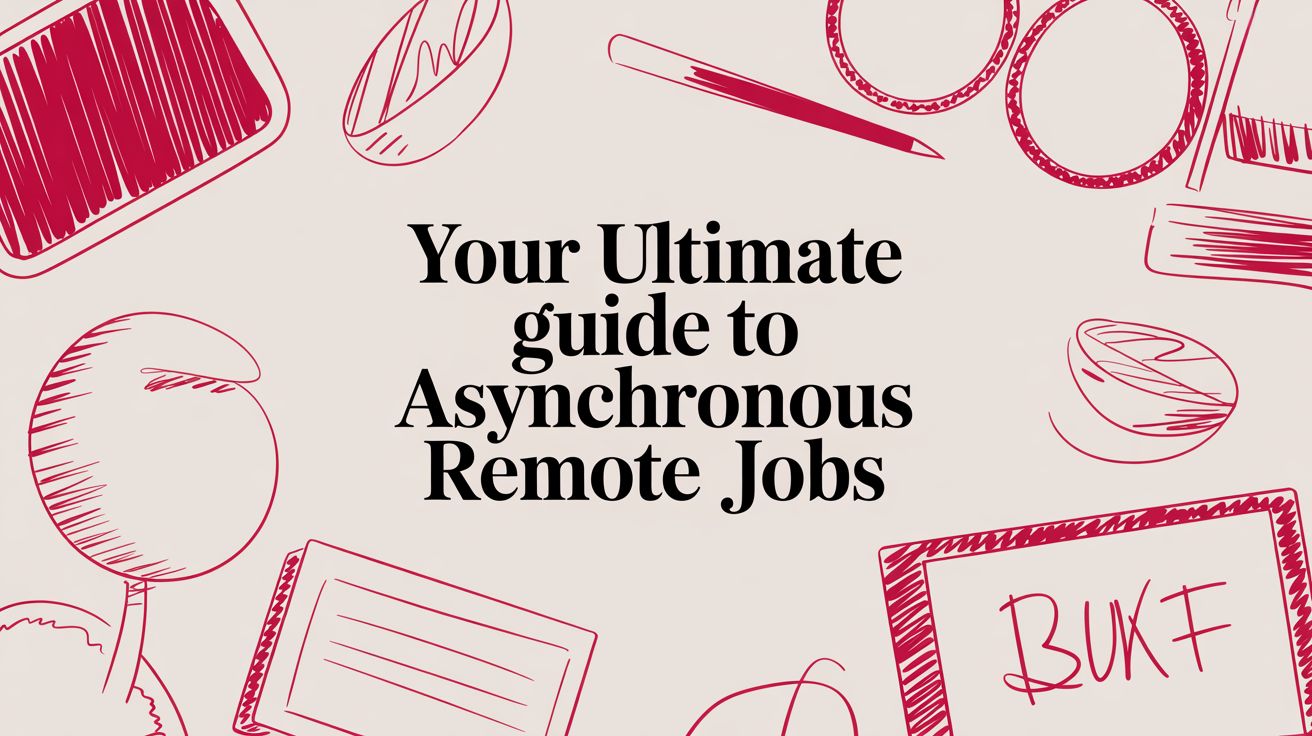How to Write Job Descriptions That Attract Talent
Max
Writing a great job description isn’t just about listing tasks. It’s about capturing the role’s core impact, using punchy, action-oriented language, and being upfront about qualifications and compensation. It needs to be clear, compelling, and authentic to grab the right person’s attention and set honest expectations from day one.
The True Cost of a Bad Job Description
Think of your job description as your company’s first handshake with a potential team member, not just another HR form to fill out. It’s a powerful marketing tool. It’s the very first impression someone gets of your brand, your culture, and the opportunity you’re offering. A poorly written one doesn’t just get ignored—it actively sabotages your hiring process.
When you fall back on generic templates or vague, corporate-speak, you’re basically sending out an open invitation for mismatched applications. This just wastes everyone’s time, clogs your pipeline with frustrating interviews, and drags out the entire hiring cycle. Even worse, top-tier professionals can spot a low-effort job description from a mile away and will just keep scrolling, assuming the role (and the company) are equally uninspired.
The Ripple Effect of a Weak First Impression
That job description is ground zero for the entire candidate experience, a journey that shapes your employer brand for years to come. A confusing or boring post doesn’t just get passed over; it can lead to negative chatter that spreads quickly through professional networks.
Getting this wrong comes with some serious consequences:
- Wasted Resources: Your team sinks hours into screening and interviewing people who were never going to be a good fit in the first place.
- Lost Talent: The best candidates are looking for a clear, compelling story that shows them exactly how they can make a difference. A generic post makes you invisible to them.
- Higher Turnover: When a new hire shows up and finds the reality of the job doesn’t match the description’s promise, they’re far more likely to leave within the first year. That means you’re right back where you started, footing the bill for the whole process again.
A job description is your most critical hiring asset. Investing the time to write an authentic, clear, and engaging narrative upfront is the single best way to improve your quality of hire and streamline your entire recruitment funnel.
To give you a clearer picture, let’s break down what makes a job description truly effective.
Core Components of a High-Impact Job Description
This quick summary breaks down the essential elements of a successful job description, providing a clear roadmap for the rest of the guide.
| Component | What It Achieves |
|---|---|
| Compelling Job Title | Grabs attention and accurately reflects the role’s seniority and focus. |
| Authentic Company Intro | Sells your mission and culture, helping candidates see themselves on your team. |
| Clear Role Summary | Provides a concise “why” for the role, connecting it to company goals. |
| Action-Oriented Responsibilities | Details daily tasks and long-term impact using strong verbs. |
| Must-Have vs. Nice-to-Have Skills | Separates essential qualifications from preferred ones to broaden the talent pool. |
| Transparent Compensation & Benefits | Builds trust by clearly stating salary ranges and perks from the start. |
Each of these pieces works together to create a powerful tool that does more than just fill a seat—it attracts the right long-term partner for your team.
Shifting from Task List to Strategic Asset
The best recruiters are moving away from the “copy and paste” approach. Writing a job description is becoming much more scientific, with teams using data analytics to see what works. They track metrics like click-through rates and application completions to figure out which words and formats actually connect with candidates. It’s a data-driven strategy designed for maximum impact.
Ultimately, the goal is to create a document that doesn’t just describe a job but sells a career opportunity. It should anticipate and answer a candidate’s biggest questions: What will I actually achieve in this role? How will I grow here? And why should I choose this company over all the others?
When you shift your mindset from “administrative task” to “strategic marketing,” you set the stage for a much smoother and more successful hire.
Define the Role Before You Write a Word

Here’s the single biggest mistake people make when writing a job description: they start writing way too soon. The most critical work happens before a single word is typed. It’s all about defining the role with absolute, undeniable clarity. If you build a job description on a foundation of assumptions, you’re guaranteed to attract the wrong people, wasting everyone’s time and money.
Think of this pre-writing stage as a collaborative discovery process, not just another task for HR to check off a list. Your real goal is to get past a simple list of duties and truly understand the why behind the role. This means sitting down with the hiring manager and other key team members to paint a detailed picture of who you’re actually looking for.
Create a Realistic Candidate Persona
Instead of jumping straight to a dry list of qualifications, take a step back and think about the person who will knock this role out of the park. This isn’t about demographics; it’s about their professional DNA. What gets them excited to start the day? What kind of problems do they love to solve?
Building a candidate persona helps you write a description that speaks directly to the right audience.
Get together with the hiring team and ask questions like:
- What are their core skills? Go beyond the technical stuff. What’s their communication style? How do they approach problems? Do they thrive in a team or on their own?
- Where are they in their career? Are you looking for someone eager for mentorship and growth, or do you need a seasoned pro who can own this function from day one?
- What makes people successful here? Look at your current high-performers. What traits do they share? Is it being proactive, having an insane eye for detail, or always seeing the big picture?
This simple exercise transforms a vague idea into something tangible. You’re no longer hiring “a marketer.” You’re hiring “a data-driven marketer who gets a thrill from optimizing campaigns and loves working with sales to see a direct impact on the bottom line.” See the difference?
Conduct a Thorough Role Analysis
With a clear persona in mind, it’s time to dig into the role itself. This goes way deeper than just listing out daily tasks. It’s about defining what success actually looks like and figuring out this role’s place in the larger company ecosystem.
The image above shows the formal process of job analysis, which is just a systematic way of gathering all the details about a role’s duties, responsibilities, and the environment it exists in. This analysis gives you the raw material you need to ensure your job description is an honest reflection of reality.
The goal of a role analysis is to sell a genuine career opportunity, not just fill a vacancy. You need to understand the role’s challenges, impact, and growth trajectory before you can compellingly communicate it to others.
To get the real story, you have to ask the hiring manager specific, probing questions. Don’t let them off easy.
- What is the one thing this person absolutely must achieve in their first six months?
- What are the biggest challenges or frustrations they’re going to face? (Be honest!)
- How does this job directly help the team and the company hit their main goals?
- What does an average day or week really look like? No sugarcoating.
The answers to these questions give you the substance for a compelling and, most importantly, honest job description. You’ll walk away with a crystal-clear list of must-have skills—a key part of what’s known as skills-based hiring—and the nice-to-haves that will separate the good candidates from the great ones.
Putting in this foundational work ensures your job description acts as a powerful magnet for exactly the right talent.
Alright, you’ve done the prep work. Now it’s time to actually build the job description. Think of this less like filling out a form and more like telling a story—one that gets the right person excited to join your team.
Let’s break down how to craft each section, turning them from boring checklists into compelling reasons to apply.

Craft a Clear and Searchable Job Title
Your job title is the headline. It’s the first thing a candidate sees, and it has to be both accurate and easy to find. Getting creative here is a huge mistake.
Candidates search for specific, standard titles. Internal jargon or flashy, made-up titles like “Growth Ninja” just won’t show up in their search results. Think like the person you want to hire. Would they look for “Digital Marketing Manager” or something they’ve never heard of? Stick to what’s familiar and keyword-friendly.
Seniority matters, too. “Senior Software Engineer” sets completely different expectations than “Software Engineer.” Be precise.
Before: Growth Hacker After: Senior SEO Marketing Manager
That simple change makes the role instantly clear and vastly improves its chances of being discovered.
Write a Company Summary That Sells Your Culture
This is your elevator pitch. Don’t just drone on about what your company does; tell people why it matters. This section should give a candidate a real taste of your mission, your values, and what it’s actually like to work with you.
Forget the clichés. “Work hard, play hard” means absolutely nothing. Instead, give concrete examples of your culture.
Do you have a mentorship program? Truly flexible hours? A unique way you collaborate on projects? Talk about that. This is your chance to show candidates you’ll support them and that your team is one they’ll want to be a part of.
A great company summary helps a candidate see themselves on your team. It’s where you connect their personal values to your company’s mission, turning a job into a genuine opportunity.
Detail Responsibilities with Action Verbs
The responsibilities section is the heart of the JD, but it’s often just a dull laundry list of tasks. The key is to reframe it around impact, not just duties.
Start every single bullet point with a strong, action-oriented verb that shows what the person will achieve.
For instance, instead of “Responsible for social media accounts,” try “Develop and execute a cross-platform social media strategy to increase audience engagement by 25%.” See the difference? One is passive, the other shows ownership and connects the work to a real business outcome.
Here are a few strong verbs to get you started:
- Analyze customer data to identify market trends.
- Architect scalable back-end services for our core application.
- Spearhead the quarterly content planning process.
- Collaborate with the product team to define new feature requirements.
This approach transforms the role from a list of chores into a dynamic preview of the real contributions your new hire will make.
Define Qualifications That Attract, Not Deter
This is where so many job descriptions go wrong. It’s easy to create a massive wish list that inadvertently scares away perfectly good candidates. You absolutely have to distinguish between true must-haves and nice-to-haves.
An endless list of requirements is intimidating. It can also disproportionately discourage applicants from underrepresented groups from even trying.
Sit down with the hiring manager and pinpoint the absolute essential skills someone needs to succeed from day one. Everything else is a bonus. Clearly separating these two categories signals that you’re open to people from different backgrounds and with varied experiences. For a great example of this, check out our guide on Data Analyst job requirements, which breaks down how to balance technical skills with real-world experience.
Example Qualification Split
Required Qualifications:
- 3+ years of experience in a product marketing role for a SaaS company.
- Demonstrated success in launching at least two major product features.
- Excellent written and verbal communication skills.
Preferred Qualifications:
- Experience working with enterprise-level clients.
- Familiarity with marketing automation tools like HubSpot or Marketo.
- A basic understanding of SQL for data analysis.
Be Transparent with Salary and Benefits
Including a salary range isn’t just a nice-to-do anymore; in many places, it’s the law. But beyond that, it’s about respecting a candidate’s time. A 2023 survey found that 75% of employers agree that pay transparency helps them attract better candidates.
Being upfront about compensation builds trust from the very first interaction. It immediately weeds out anyone whose expectations don’t align with your budget, saving everyone a ton of time.
List your key benefits clearly—don’t just say “competitive benefits.” Get specific. Mention your health coverage, 401(k) matching, home office stipends for remote roles, or professional development budgets. This kind of transparency is a powerful magnet for serious, high-quality applicants.
Write Inclusively to Attract Diverse Talent

The language you use in a job description does a lot more than just list tasks—it sends a powerful signal about your company culture. Think of it as your first handshake with a potential hire. An inclusive description is your best tool for attracting a wide range of perspectives, which is the foundation of any resilient and innovative team.
Without it, you could be unintentionally shrinking your talent pool before a single application lands in your inbox.
It really comes down to a conscious effort to remove unconscious bias from your writing. This means taking a close look at every word, phrase, and qualification to make sure they invite, rather than deter, talented people from all backgrounds. The goal is to write a description where every qualified candidate feels seen, respected, and confident enough to hit “apply.”
Avoid Gender-Coded Language
Subtle word choices can have a massive impact. It’s easy to forget that language often carries unconscious gender biases that can influence who feels welcome to apply. Words like “dominant,” “aggressive,” or “ninja” tend to be masculine-coded and can discourage women from applying.
On the flip side, terms like “nurturing,” “supportive,” or “collaborative” can sometimes have the opposite effect. This isn’t about banning these words entirely, but about being mindful and opting for more neutral, skill-focused language.
For example, instead of asking for a “dominant” leader, you could ask for someone with “strong decision-making skills.”
Here’s how a simple swap can make a world of difference:
Instead of: “We need a rockstar developer who can crush code.”
Try: “We’re looking for a skilled developer proficient in building efficient applications.”
Instead of: “Seeking a nurturing team player to support our clients.”
Try: “Seeking a proactive team member dedicated to excellent client service.”
“The language of your job description is a gate, not a filter. Inclusive wording opens the gate wider for everyone who is qualified, rather than filtering out great candidates for reasons that have nothing to do with their ability to succeed in the role.”
This small shift ensures you’re evaluating candidates on what truly matters—their actual abilities—not on some outdated idea of who fits a particular mold.
Re-Evaluate Your “Must-Have” Requirements
One of the most common pitfalls is creating an intimidating “laundry list” of qualifications. We’ve all seen them. Research has consistently shown that men often apply for jobs when they meet just 60% of the qualifications, while women and people from other underrepresented groups tend to apply only if they meet 100%.
That means a long, overly specific list of requirements can be a huge deterrent.
Take a hard look at every single qualification on your list and ask yourself one simple question: “Is this skill absolutely essential for someone to do this job on day one?”
If the answer is no, move it. Create a separate “Preferred Qualifications” or “Nice-to-Have” section. This simple act of organization instantly makes the role feel more accessible and less like an impossible checklist.
For instance, requiring a “degree from a top-tier university” can be a form of gatekeeping that excludes incredibly talented people who gained their skills through experience, certifications, or other non-traditional paths. Focus on the skills themselves, not where they came from. Thinking about inclusion is a core part of building effective diversity recruiting strategies that will strengthen your entire organization.
By consciously choosing inclusive language and being ruthless with your “must-have” list, you aren’t lowering your standards. You’re widening your net to catch the best possible talent out there, building a team that’s richer in experience, perspective, and problem-solving power.
Optimize Your Job Post for Search and Scannability
You’ve poured your energy into crafting a job description that’s clear, compelling, and inclusive. But what good is the perfect description if the right candidates never see it?
Getting your post in front of the right people means you have to think like a marketer. This involves a blend of smart search engine optimization (SEO) and thoughtful formatting to make your post impossible to ignore.
Think of job boards like LinkedIn and Indeed as specialized search engines. To get your post to the top of the results, you need to use the exact keywords and phrases your ideal candidates are typing into that search bar. This isn’t about guesswork; it’s about simple, practical research.
Master Job Post SEO
First things first, brainstorm a list of potential job titles. A quick search on LinkedIn for “Senior Product Manager” will instantly show you common variations and related terms your competitors are using. This is your starting point.
From there, use tools like Google Trends or any keyword planner to check which terms get more search traffic. You might find that “Content Strategist” is searched far more often than “Content Architect,” giving you a clear winner.
Once you’ve locked in your primary keywords, it’s time to weave them naturally into the fabric of your job post.
- The Job Title: This is your SEO goldmine. Stick with a standard, widely recognized title.
- The Role Summary: Place your main keyword and a few secondary ones right in the first couple of sentences.
- The Responsibilities Section: Use bullet points to list duties, which is a perfect and natural way to include relevant skills and software names.
The same principles that make a blog post rank on Google apply here. For a deeper dive, check out these actionable SEO content writing tips to really make your job description more visible.
Make Your Description Scannable
Let’s be honest: nobody reads job descriptions word-for-word, especially on a phone. Candidates are scanning for key info to quickly decide if a role is worth their time. Your job is to make that scan as easy as possible.
Walls of text are your worst enemy. Break up your content into small, digestible chunks.
The average candidate spends less than a minute reading a job description. If they can’t find what they’re looking for—responsibilities, location, salary—in a few seconds, they’re gone.
Use formatting to guide their eyes. Keep every paragraph to one to three sentences max. Use bold text to highlight essential skills or qualifications. Bullet points and numbered lists are your best friends for breaking down responsibilities and requirements into a format that’s easy to skim.
Clear headings and subheadings act as signposts, helping readers navigate the content effortlessly. For more insights on structuring information clearly, it’s worth exploring these best practices for technical writing.
Highlight In-Demand Skills
The hiring world is shifting fast. It’s no longer just about years of experience; it’s about specific, tangible skills. Highlighting the exact capabilities required for the role not only attracts the right talent but also boosts your post’s visibility for those skill-specific searches.
Case in point: job postings mentioning Generative AI as a required skill shot up by an incredible 1800% between 2022 and September 2023.
So, instead of listing vague qualities, get specific with tangible skills.
Example of Highlighting Skills
| Vague Requirement | Specific Skill Highlight |
|---|---|
| “Excellent communicator” | “Experience with asynchronous communication tools like Slack and Notion” |
| “Data-savvy” | “Proficiency in SQL for querying and creating dashboards in Tableau” |
| “Project management skills” | “Demonstrated ability to manage projects using Agile methodologies in Jira” |
This level of detail does two critical things: it acts as a magnet for candidates with the exact skills you need, and it helps your job post rank higher for those niche keyword searches.
By combining smart SEO with reader-friendly formatting, you ensure your carefully crafted description doesn’t just exist—it gets seen.
Common Questions About Writing Job Descriptions

Even with a solid game plan, you’ll inevitably hit a few practical snags when you sit down to actually write. It’s often the small details that make the biggest difference in who you attract. This section is all about tackling those frequent hurdles recruiters and hiring managers face, with quick answers to help you sharpen your approach.
Getting these details right is what separates a job description that just informs from one that truly sells the right talent on your role. Let’s dig into the common sticking points and how to handle them.
How Long Should My Job Description Be?
It’s a delicate balance. You need enough detail to be useful, but not so much that you send people running.
The sweet spot is usually between 300 and 700 words. Anything shorter, and you risk leaving out the critical info that helps a qualified person decide if they’re a good fit. That’s how you end up with a flood of applications from people who are all wrong for the job.
On the flip side, if it’s too long, you’ll lose their attention—especially on mobile, where everyone is scanning. Keep your focus on the core responsibilities, the absolute must-have skills, and the most compelling reasons someone should be excited to join your team.
Focus on clarity over word count. Use bullet points and clean headings to make the post a breeze to scan. Your goal is to give a candidate just enough information to make a smart decision without burying them in text.
Should I Always Include a Salary Range?
Yes. Full stop. In today’s world, pay transparency isn’t just a nice-to-have; it’s a massive competitive advantage.
Sure, many places now have laws requiring salary ranges on job posts. But even if they don’t, including the compensation shows you respect a candidate’s time and builds trust right out of the gate. The data doesn’t lie: job posts with salary info consistently attract more high-quality applicants.
It also saves everyone a ton of time by making sure you’re only talking to people whose expectations actually line up with your budget. If you’re hesitant because of internal pay scales, this is a great opportunity to get your own house in order and standardize your compensation strategy. Being upfront about pay is one of the single best things you can do to make your hiring process more efficient.
What Are the Biggest Mistakes to Avoid?
Even with the best intentions, a few common slip-ups can torpedo an otherwise fantastic job description. Just knowing what they are is half the battle.
Here are the most common offenders I see:
- Using Internal Jargon: Ditch the acronyms and company-specific lingo that an outsider won’t get. It’s an instant turn-off and makes the role feel like it’s part of an exclusive club they can’t join.
- Creating a “Laundry List” of Requirements: An intimidatingly long list of “must-haves” will scare away great candidates, especially women and people from underrepresented groups. Be ruthless about separating what’s truly essential from what’s just a nice-to-have.
- Relying on Vague Clichés: Phrases like “fast-paced environment” or “team player” are empty calories. They mean nothing without context. Instead, show what that looks like in the role (e.g., “You’ll be juggling multiple project deadlines each week and collaborating daily on Slack.”).
- Copying an Old Job Description: This is a huge mistake. Roles change constantly. A recycled description is a recipe for a bad hire because it fails to capture what the job actually requires today.
How Do I Make a Remote Job Description Stand Out?
When you’re hiring remotely, you’re not just competing locally—you’re up against the whole world. Simply listing the location as “Remote” isn’t nearly enough. You have to paint a clear picture of the entire remote experience.
First, define your policy with zero ambiguity. Is the job fully remote? Hybrid? Remote-first, but you need someone in a specific time zone? Any confusion here will just create headaches down the line.
Beyond the logistics, you have to sell your remote culture. Highlight the skills that are non-negotiable for remote success, like asynchronous communication, proactive collaboration, and self-management. Talk about how your team actually builds connections when you’re not sharing an office.
Be sure to call out any specific perks that make remote life better:
- A stipend for a home office setup
- Genuinely flexible work hours
- Fun virtual team events (that people actually enjoy)
- The collaboration tools you rely on, like Slack, Notion, or Asana
Sharing these details shows you’re intentional about creating a great remote environment, which is a massive draw for top remote talent who have plenty of options.
Ready to find the perfect remote talent for your team? Remote First Jobs offers a seamless job posting process designed to give your roles maximum visibility. Post your job today and connect with thousands of qualified candidates looking for their next great remote opportunity.
Find your next hire at https://remotefirstjobs.com.


